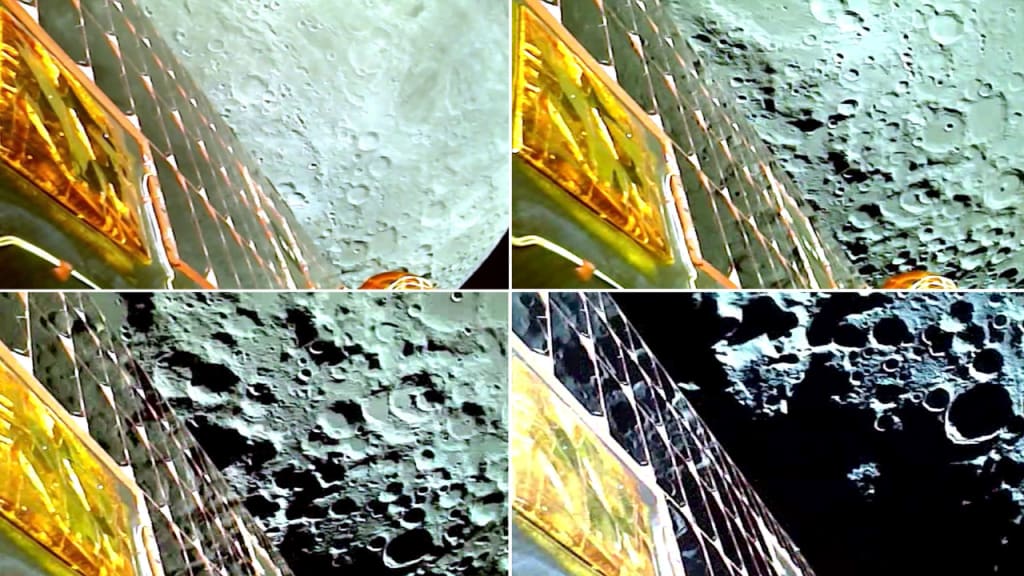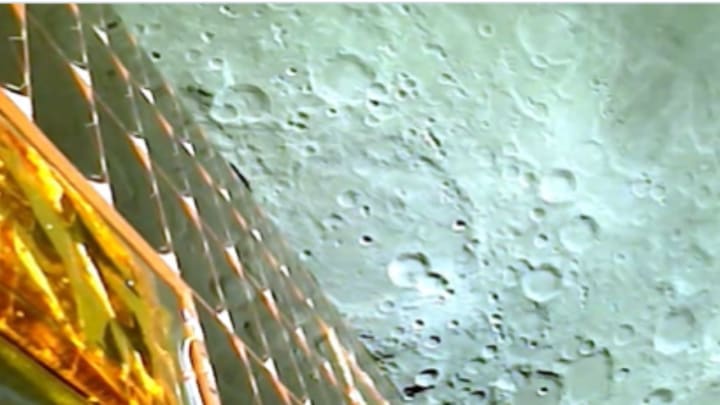First Images of the Moon from Chandrayaan-3
The Indian Space Research Organisation (ISRO) has released the first images of the Moon taken by its Chandrayaan-3 spacecraft. The images show the lunar surface in great detail, and they provide scientists with new insights into the Moon's geology.

The Indian Space Research Organisation (ISRO) has released the first images of the Moon taken by its Chandrayaan-3 spacecraft. The images show the lunar surface in great detail, and they provide scientists with new insights into the Moon's geology.
The images were taken on August 5, 2023, after Chandrayaan-3 successfully entered lunar orbit. The images show a variety of features on the lunar surface, including craters, mountains, and plains. The images also show evidence of water ice on The Moon.
The images from Chandrayaan-3 are a major milestone for Indian space exploration. They are also a valuable resource for scientists who are studying The Moon. Images will help scientists to better understand the Moon's formation, evolution, and potential for future exploration.
In addition to the images, Chandrayaan-3 also carried a number of scientific instruments. These instruments will be used to study the Moon's surface, atmosphere, and interior. The data from these instruments will help scientists to answer some of the most pressing questions about the Moon.
The successful launch and operation of Chandrayaan-3 is a testament to the skill and dedication of the ISRO team. he mission is a major achievement for India, and it will help to advance our understanding of the Moon.
What are the implications of these images?
The first images of the Moon from Chandrayaan-3 are a major scientific breakthrough. They provide us with new insights into the Moon's geology and history. The images show that the Moon is a dynamic and complex world, with a variety of features that have been shaped by billions of years of geological processes.
The images also provide us with new clues about the Moon's potential for future exploration. The presence of water ice on the Moon is particularly significant, as it could provide a valuable resource for future astronauts.
The images from Chandrayaan-3 are a major step forward in our understanding of the Moon. They will help us to better plan future missions to the Moon, and they will also help us to understand the Moon's place in the history of our solar system.
What's next for Chandrayaan-3?
The next phase of the Chandrayaan-3 mission is to land the lander and rover on the Moon. The lander is scheduled to touch down on the Moon on September 7, 2023. The rover will then explore the lunar surface for up to 14 days.
The lander and rover will carry a variety of scientific instruments. These instruments will be used to study the Moon's surface, atmosphere, and interior. The data from these instruments will help scientists to answer some of the most pressing questions about the Moon.
The Chandrayaan-3 mission is a major milestone for Indian space exploration. It is also a valuable resource for scientists who are studying the Moon. The images and data from the mission will help us to better understand the Moon's formation, evolution, and potential for future exploration.

here more information about the first images of the Moon from Chandrayaan-3:
• The images were taken by the Chandrayaan-3 Orbiter Camera (OCAM). The OCAM is a high-resolution camera that can image the Moon in great detail. The images have a resolution of up to 0.6 meters per pixel.
• The images show a variety of features on the lunar surface, including craters, mountains, and plains. The images also show evidence of water ice on the Moon.
The water ice is found in the polar regions of the Moon. It is believed to have been deposited there by comets and asteroids that crashed into the Moon billions of years ago.
• The presence of water ice on the Moon is a major finding. It could provide a valuable resource for future astronauts. Water could be used to drink, to grow food, and to generate fuel.
• The images from Chandrayaan-3 are a major scientific breakthrough. They provide us with new insights into the Moon's geology and history. The images also provide us with new clues about the Moon's potential for future exploration.
• The Chandrayaan-3 mission is a major achievement for India. It is also a significant contribution to the global effort to explore the Moon. The images and data from the mission will help us to better understand the Moon and its place in the history of our solar system.
What are the future implications of these images?
The first images of the Moon from Chandrayaan-3 are a major scientific breakthrough. They provide us with new insights into the Moon's geology and history. The images show that the Moon is a dynamic and complex world, with a variety of features that have been shaped by billions of years of geological processes.
The images also provide us with new clues about the Moon's potential for future exploration. The presence of water ice on the Moon is particularly significant, as it could provide a valuable resource for future astronauts.
The images from Chandrayaan-3 are a major step forward in our understanding of the Moon. They will help us to better plan future missions to the Moon, and they will also help us to understand the Moon's place in the history of our solar system.
The future implications of these images are far-reaching. They could lead to new discoveries about the Moon's geology, history, and potential for future exploration. They could also inspire new generations of scientists and engineers to pursue careers in space exploration.
The images from Chandrayaan-3 are a testament to the skill and dedication of the ISRO team. They are also a reminder of the importance of international cooperation in space exploration. The images from Chandrayaan-3 are a global achievement, and they will help us to better understand our place in the universe.





Comments
There are no comments for this story
Be the first to respond and start the conversation.